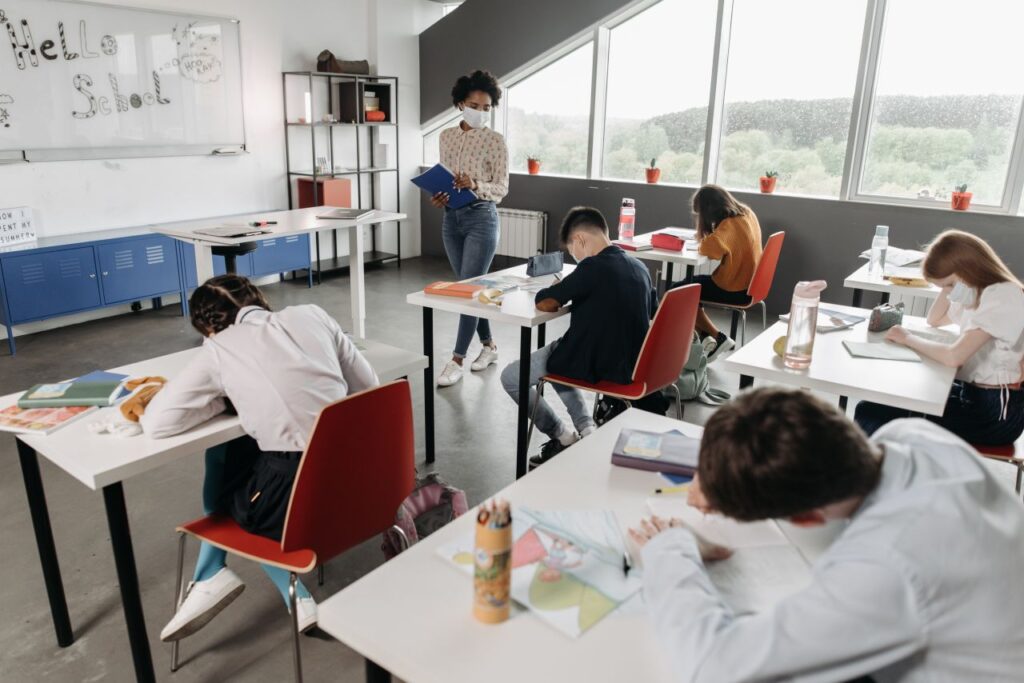No one said that being a teacher would be easy but rewarding. Likewise, maintaining a positive mindset in the classroom can be challenging, especially when things get tough. But don't worry, we've got you covered! In this post, we will share some tips on how to stay upbeat throughout the school year. Keep reading for more information.
A Positive Mindset In The Classroom
A positive mindset is essential in the classroom because the positive mindset towards learning can boost the function's mind's memory. Nowadays, a school may burden students as students have so much homework, sports, and other activities. Because of this, students have many negative thoughts in their minds. Negative thinking is like a giant wall that closes you in. It keeps students away from executing goals and blocks them from moving forward in life. Whether it is developing, learning, or acquiring happiness, negative thoughts block each and everything in a student's life.
Negative thinking can also hold a student back from their true perspective. So it's crucial to maintain a positive mindset of students in the classroom. But the question arises about maintaining a positive mindset in the classroom? For this, the teachers and even parents can play a massive role in teaching students how to think positively. Teachers must have the energy to maintain a positive mindset to make them successful in life in the classroom.
Positive thinking has several mental, emotional, and physical benefits. Along with this, a positive attitude can assist students in coping with stress, enhance students' overall wellbeing, and even boost their immune systems. The studies also have shown that positive thinking can influence students' ability to solve problems and learn new things. In addition, positive thinking assists students to feel more relaxed and happier, making it easier to focus on tasks and grasp new knowledge.
The teachers know that encouraging a positive learning atmosphere must go to excellent lengths to ensure that their classrooms are places where students will feel engaged and supported and vital to their success. If the students cannot learn how teachers teach them, it's essential to teach how they love to learn. A school is a place to learn, bring up, and convey students' energy.
Frequently Asked Questions
How does positivity affect students and teachers? First, positivity makes it easier to achieve your goals. That's because when you're in a positive frame of mind, you can make better decisions. You can look ahead and plot a course rather than just reacting to the setbacks you encounter.
For teens, in addition to making them feel better, positive thinking can improve their memory, decision-making, and problem-solving skills.
Teachers who establish caring, supportive, safe, challenging, and academically robust classrooms help define a positive learning environment. An effective teacher provides a well-managed, safe, and orderly environment conducive to learning and encourages respect for all.
A positive classroom environment helps improve attention, reduce anxiety, and support students' emotional and behavioural regulation. In addition, when educators foster a positive learning culture, learners are more likely to acquire higher motivation that leads to wonderful learning outcomes.
A positive learning environment is created when you value participatory teaching and learning and trust and rapport between students and yourself and students. It can range from creating spaces for student use to class discussion to establish norms and expectations.
Here Are The Tips That How To Maintain A Positive Mindset In The Classroom:
Manage Your Stress
When you feel stressed or anxious, it becomes difficult to maintain a positive mindset in the classroom. Stress can affect the mind's capability to engage in new things. If students feel stress and anxiety in the classroom, they cannot focus on their studies, so it's important to manage the anxiety and find effective ways to cope and manage stress. Getting classified is one of the most effective ways of managing stress. It helps you view new situations as exciting rather than stressful and offers you a feeling of acknowledgement.
Set Your Own Learning Goals
To maintain a positive mindset in the classroom, it's also important to set your own learning goals. Setting clear learning objectives and then tracking their progression is one of the finest ways to enlarge achievements and enhance stimulation. The goal setting is enabling, and it appears to improve self-monitoring and enhance performance and determination in several settings, from the classroom to the workplace. In addition, the learning goals help students stay organised and permit you to see their progress more clearly.
Push Yourself To Do More Each Day
It's one of the major characteristics of maintaining a positive classroom mindset. A positive mindset means believing in yourself and your capabilities. If you want to keep a positive mindset, you should test your limits daily. Every day you do as much hard work as you can. It's essential to do more work today than you did yesterday. If you push yourself to test your limits each day, it will exhibit that you are capable, skilled, and talented, making it easier to stay positive. In addition, if you push yourself to do more each day, it will give you more confidence.
Surround Yourself With Positive People
If you want to maintain a positive mindset in the classroom, then the surroundings also matter a lot. The surroundings that you keep also have a massive impact on your attitude. If you spend your time around people with a negative mindset who always complain about everything, you also start acting like them. So to maintain a positive mindset, it's essential to surround yourself with positive people. Try to make friends who are motivating and rarely complain about things. Friends with a positive mindset also help you in your studies.
Learn From Your Mistakes
For a positive mindset, it's essential to learn from your mistakes. However, the mistakes are avoidable, but they are also essential in learning new things. If you acknowledge the worth of making mistakes, you will be capable of using those mistakes for growth and progress instead of worrying that you are always failing. When you fail in, you are your life, then learn something new from those mistakes. So it is essential to reevaluate your mistakes as chances to learn new information. For example, when you answer a question incorrectly, then instead of thinking negatively, recognise your mistake and then look at what went wrong and how you can prevent it from happening again in the future.
Maintaining a positive mindset all the time may be difficult for students, even all of us; however, it doesn't mean we should not try harder to maintain a positive attitude. So if you are wondering how to maintain a positive mindset in the classroom, you must follow these essential tips.
Practical Tips On How To Develop A Positive Attitude In Students
We know for a fact that positive thinking is good for our physical, mental, and emotional health. So consider these strategies to inspire a positive attitude and teach your virtual school student how to think positively this year and beyond:
Check Your Style.
As a teacher, you must have a detailed look at your personality and interact with everyone. Then you need to bring a positive approach to all your actions. Merely directing someone to do something is not enough. If the students see you glowing with positive energy, they'll be more likely to inherit it from you naturally.
Regarding positivity in the classroom, you can regulate how you react to your student's mistakes. Rather than scolding or even using little words to discourage them, always lift their energy by giving alternate solutions to rectify the mistake. It'll then become natural to the students that they must always thrive to improve rather than go on a guilt trip. Further, don't react to their mischiefs like a typical professor; instead, have a little fun with them on it, then again bring them back to studies. This cycle of fun and studies will create a unique bond between you and your students.
Initiate Visualisation
You can initiate the habit of visualising before working on any project to know its possible outcomes. You can explain to them that the possible outcomes can either be positive or negative, but what needs to be constant is their perspective towards it, positive to be precise. This kind of activity will develop your students to be more analytical in life and be more accepting of any situation. You can also work on how they react when they receive fewer marks for the latter. At such time, if you encourage them yourself with "will do better next time," they'll have a far-reaching positive impact on themselves.
Be An Example.
Model a positive, encouraging attitude in everything you say, do and believe. Optimism is contagious. Positive thinking tends to breed positive outcomes, and if your child sees positive outcomes from your attitude, they are more likely to want to experience the same positive outcomes. Show how optimism creates an ideal environment for happiness and how positivity influences the probability of success for any goal you may have. Sometimes seeing is believing, and there's no better place for your child to see it than within you.
Create A Positive Learning Space For Your Student.
What better way to inspire optimism than establishing an encouraging environment? As you create a planner or decorate your child's online school workspace, post several positive quotes to keep motivation high. Here are some optimistic quotes for students. Maybe make it fun and turn your favourite positive quotes into kitchen magnets. A positive environment can do wonders for eliminating negative thinking and encouraging healthy thoughts as your student tackles new learning challenges and opportunities.
Help Your Student Visualise Positive Outcomes For All Scenarios.
It's important to plan goals with your student regularly, and when doing so, clearly set the stage for what success looks like. For example, how will it feel to accomplish the goal? What will the reward be? Answering all of these questions can get your student excited about working toward the goal and will remind them of the positive outcomes to look forward to.
Eliminate Negative Talk.
When you hear your student say, "I can't do it," take a step back. Bring this negative attitude to your child's attention. Dive deeper into the meaning behind it. Ask questions:
- "Why can't you do it?"
- "What's holding you back?"
- "How can I help?"
- "What do you need to be able to do it?"
From there, layout a plan to remove those barriers. Show your child that you are in this together, and together you can come up with a plan to turn "I can't" into "We can."
Additionally, volunteering or giving to someone in similar or more dire circumstances than yourself can impact reversing negative attitudes into positive ones. Sometimes all that is needed is a shift in perspective.
Find volunteer opportunities for kids of all ages, and help your student see past their challenges.
Help Your Students Change Negative Thinking Patterns.
As you bring your child's negative words and thoughts to their attention, make sure you encourage them to replace the negative attitude with a positive one. It is a form of cognitive behavioural therapy designed to change people's thinking or behavioural patterns linked to certain difficulties. In this case, the concept is simple: when you have a negative thought or reaction, notice it and replace it with a positive response. The more your student does this, the more positive their thoughts, words, and actions are.
Be Your Student's Biggest Fan.
As an online school parent or Learning Coach, your attitude greatly influences your child's self-confidence. Your belief in your student can help them learn to feel confident and self-accepting. Consider trying some of these self-acceptance activities to make your child aware of their unique strengths and weaknesses. In turn, your home school student can begin thinking positively, developing self-esteem, and embracing their identity.
Set Up A Rewards System That Encourages Positivity.
It's not unusual for children to lack the motivation to be positive, especially when dealing with a defeat or a sense of failure. Setbacks are a part of life, but how do you teach a child to keep their chin up when things are going badly? The answer may be a rewards system that provides positive reinforcement for optimism. Follow these steps to implement a rewards system for your youngster.
How Does Positivity Affect Students And Teachers?
Positivity makes it easier to achieve your goals. That's because when you're in a positive frame of mind, you can make better decisions. You can look ahead and plot a course rather than just reacting to the setbacks you encounter. You don't get stuck with negative self-talk. Here are five reminders about the importance of a positive attitude for students.
Easier To Ask For Help
It's also easier to ask for help when you're feeling positive. It means when you see an obstacle in your path, you're more likely to reach out to a teacher or parent for advice. Soaking in their wisdom can be just what you need to overcome your obstacle and find success.
Positivity Can Even Improve Your Health.
One way that positivity can boost your health is by lowering your blood pressure and heart rate. When you're experiencing negative emotions like anger or fear, your body will begin producing adrenaline, the flight-or-fight hormone. It is a great mechanism when faced with an emergency like a serious car accident or house fire. But when you're faced with something less intense, like turning in a paper or taking an exam, that adrenaline response isn't helpful. Fortunately, positivity makes it easier to relax and manage stress, so you don't have to spend the day feeling like you're on a rollercoaster.
Positivity Increases Your Satisfaction In Life And School.
It's easy for students (and adults) to get focused on everything wrong in the world, and it's tempting to spend your time looking at what everyone else has. But all of that wishing and jealousy is just another form of negativity.
When you choose to embrace positive thoughts and focus on what you're grateful for and successful, you stop comparing yourself. Instead, you can see all the amazing things around you—like your teachers, friends, and family.
Positivity Helps You Grow.
Positivity can be useful by prompting students to take risks and try new things in the classroom and at home. For example, students might experiment with taking trumpet lessons and discover that they love the instrument, or they might try running and find their new favourite exercise routine.
Learn From Your Mistakes.
Of course, being positive and taking a risk doesn't mean everything will turn out the way we might have hoped. However, students who learn from their mistakes can still focus on the positive side of things. Maintain a positive outlook, and appreciate the valuable lessons and wisdom, and students can share those experiences as well.
Combine positive affirmations for kids and proprioceptive input with The Positive Path. Children can jump along the path or do wall push-ups while reading encouragement words. Students can benefit from proprioceptive input to help get their bodies ready to learn. The Positive Path highlights the importance of a positive attitude for students.
Conclusion
It is important to take care of yourself mentally and physically. Ensure you get enough sleep, eat healthy foods, and exercise regularly. Additionally, find ways to connect with your students personally and build relationships of trust. When we feel supported by our classmates and teachers, we are more likely to succeed in school.


